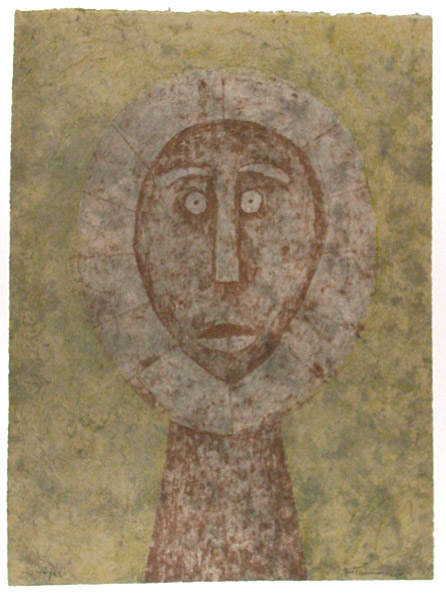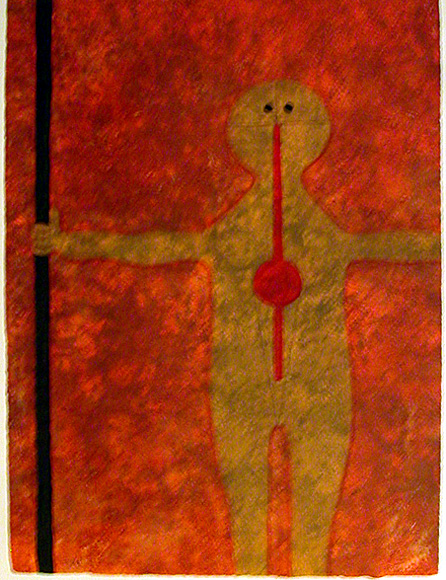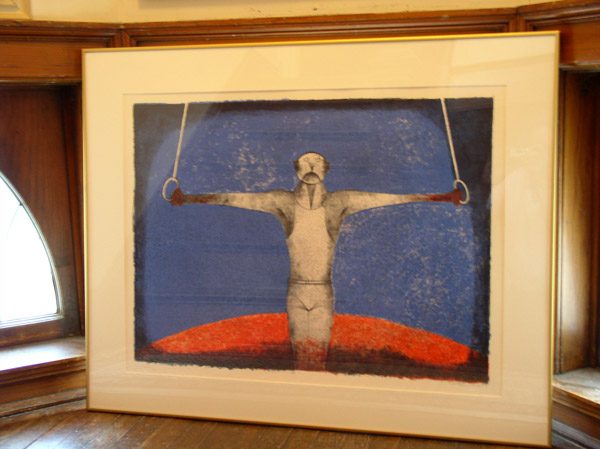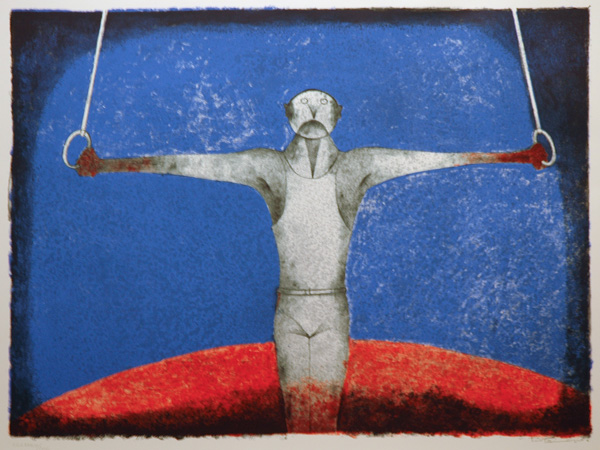Rufino Tamayo, one of the great masters of the 20th century, combined the ancient with the contemporary in his art. Tamayo came of age during the period after the Mexican Revolution when the revolutionary murals of Diego Rivera, J. C. Orozco, and David Alfaro Siqueiros were held up as models for all to admire and follow in creation a new independent, socialist Mexico. Tamayo painted on an easel and his models were the masters of Modern Art, Picasso, Cezanne, and Braque. His subjects, however, however abstractly treated, were Mexican to the core. A serious collector of Pre-Columbia Mexican art, Tamayo, whether living in New York, Paris, or Mexico City, tried to find the soul of a modern Mexico in the sculptures of its pre-European past. Likewise, his colors owed nothing to the European artists who interested him, but reflected the skies, earths, and landscapes of Mexico as well as the dyes used in Mexican clothes.
Although he had made many lithographs, including a series on the Apocalypse and several series on Mexican women, Tamayo began to experiment with etchings late in his life. In 1974 he began working at the Mixografia Workshop in Mexico City, where he combined molded relief printing with lithography, usually beginning by making a lithographic tone plate, working in wax, which was then used as a model for copper plates, and printing them on top of the lithographic background, producing a rich, three-dimensional surface. In 1979 and 1980, Tamayo worked at Ediciones Poligrafa in Barcelona, combining carborundum plates (copper plates sculpted with epoxy resins) and etching. The four works below are the products of Tamayo's first sojourn at Poligrafa and include some of his richest graphic works. Also illustrated below is Tamayo's contribution to the abortive 1988 Olympic Art Portfolio project. Although the works were printed, they were never published due to the bankruptcy of the project.
Tamayo's works are to be found in many important collections of modern art including the Museum of Modern Art and the Guggenheim Museum (NYC), The Art Institute of Chicago, The Albright-Knox Gallery in Buffalo, The Fogg Art Museum at Harvard University, The Philadelphia Museum of Art, the Cleveland Museum of Art, the San Francisco Museum of Modern Art, the Minneapolis Institute of Art, the Philips Collection, Washington D.C., the Tate Gallery, London, the Musee Royale, Brussels, the Museum of Fine Arts, Jerusalem, the Museo de Bellas Artes, Caracas, the Museo de Arte Moderno, Mexico City, the Museo Rufino Tamayo, the Instituto Nacional de Belles Artes, Mexico City, the Museum of Modern Art, Tokyo, the Galeria Nazionale de Arte Moderna, Rome, and the Pompidou Center in Paris; his works have been shown at major museums and important galleries all over the world.
Awards: First Prize, Carnegie International, Pittsburgh, 1952; First Prize for Painting, Biennal of Sao Paolo (1953); Decorated Chevalier de la Legion d'Honneur by the French Government, 1957; Decorated Officer de la Legion d'Honneur by the French Government, 1970; Decorated Commendatore of the Italian Republic, 1971; Nominated Member of the Academy of Arts, Buenos Aires, 1959; Elected Member of the American Academy of Arts and Letters, 1961; National Award from the President of the Republic of Mexico, 1964; Guggenheim International Foundation Award, 1960, Calouste Gulbenkian Prize, French Institute, Paris, 1969.
Bibliography: Juan Carlos Pereda, ed., The Prints of Rufino Tamayo: Catalogue Raisonné, 1925-1991 (Artes Visual Turner, 2004); José Corredor-Matheos, Tamayo (NY: Rizzoli, 1987); Diana C. Du Pont, ed. et al, Rufino Tamayo: A Modern Icon Reinterpreted (Santa Barbara: Santa Barbara Museum of Art, 2007); Emily Genauer, Rufino Tamayo (NY: Abrams, 1974); Robert Goldwater, Tamayo (NY: Quadrangle Press, 1947); James B. Lynch, Jr., Rufino Tamayo: Fifty Years of His Painting (Washington D.C.: The Philips Collection, 1978); Octavio Paz, Rufino Tamayo : Myth and Magic, trans. Rachel Phillips (NY: Solomon R. Guggenheim Museum, 1979); Octavio Paz and Jacques Lassaigne, Rufino Tamayo, trans. Kenneth Lyons (Barcelona: Ediciones Poligrafa, 1982, rev 1995); Phoenix Art Museum, Tamayo: A Commentary by the Artist; An Essay by James B. Lynch, Jr. (Phoenix: Phoenix Art Museum and Friends of Mexican Art, 1968); Judith Ryan, Man, sun, space : graphic art of Rufino Tamayo (Melbourne: National Gallery of Victoria, 1987); Kathleen Slavin, Rufino Tamayo: 17 Years of Mixographia Workshoop, 1974-1991 (NY: Associated American Artists, 1993); Staatliche Kunsthalle, Berlin, Rufino Tamayo (GMA, 1990); Rufino Tamayo, Nature and the Artist: The Work of Art and the Observer (Northampton, MA: Smith College Museum of Art, 1993); Rufino Tamayo, Pinturas (Madrid: Ministerio de Cultura, 1992); Raquel Tibol, ed. Rufino Tamayo: 70 Anos de Creacion (Mexico City: Museo del Palacio de Bellas Artes, Instituto Nacional de Bellas Artes INBA, 1988); CharlesWhitchurch, et al., Rufino Tamayo (Santa Ana CA: Modern Museum of Art, 1987).
|
|





